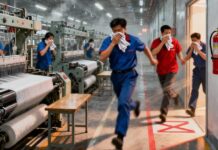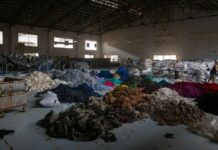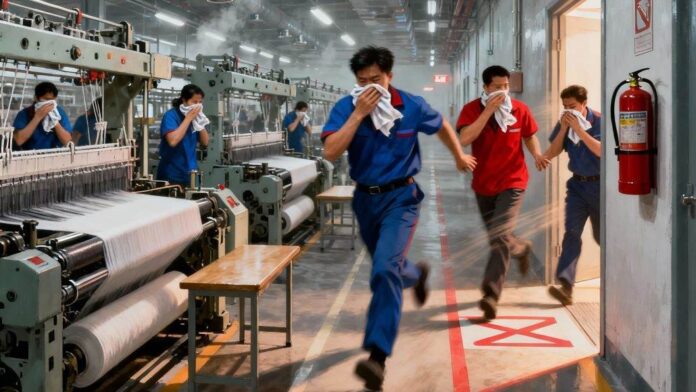Strengthening Fire Safety in Textile Factories: A Global Imperative for Prevention
On October 14, 2025, a disastrous fire engulfed a garment factory and chemical warehouse in Dhaka’s Mirpur district, claiming at least sixteen lives and injuring dozens. The inferno began on the third floor and quickly spread through stored chemicals such as hydrogen peroxide and bleaching agents. Workers trapped behind locked exits perished from toxic fumes before rescue teams could intervene. This tragedy renewed global attention on fire safety in textile factories, reminding the industry that prevention is not a compliance checkbox—it’s a moral and operational necessity.
Despite years of progress since the Rana Plaza collapse in 2013, which killed over 1,100 workers, incidents like Mirpur highlight the ongoing gaps in emergency planning, chemical management, and structural safety. For executives steering textile and apparel operations worldwide, revisiting fire safety strategies must become an industry priority.
Understanding the Hazards Behind Factory Fires
The textile supply chain is inherently high-risk: flammable fibers, dense production environments, and chemical-laden finishing units create conditions where minor sparks can evolve into massive blazes. The 2025 Bangladesh fire mirrors past tragedies such as the Ali Enterprises factory fire in Pakistan (2012) that killed 260 workers trapped behind barred windows. Both incidents reflected serious lapses in safety infrastructure and crisis response.
Common causative factors include neglect in chemical storage, overloaded electrical circuits, obstructed emergency exits, poor housekeeping, and limited worker awareness. When chemicals such as peroxides, solvents, or dyes are improperly stored or mixed, they become catalysts for combustion—an issue central to improving fire safety in textile factories.
Core Pillars of Fire Safety in Textile Factories
1. Responsible Chemical Storage and Segregation
Chemical safety is foundational to fire prevention. Reactive and flammable materials must be stored separately in ventilated fireproof rooms with explosion-proof lighting. Containers should follow GHS labeling standards and include hazard symbols, manufacturing dates, and storage instructions.
Spill containment units, bunded trays, anti-static flooring, and acid-proof cabinets are essential to prevent leaks and cross-contamination. Proper segregation eliminates dangerous reactions between oxidizers and combustible materials, reducing ignition potential.
2. Safe Emergency Exit Design
Locked or obstructed exits continue to be the deadliest safety failure. Factories must ensure unrestricted access to two functional emergency exits per floor, compliant with ISO and NFPA codes. Exit doors should open outward, include panic latches, and lead to clearly marked evacuation routes. Emergency signage and fire-rated construction materials add an extra layer of resilience.
In Dhaka’s 2025 fire, locked rooftop doors sealed workers’ fates—proof that human negligence, not technology, often determines disaster outcomes.
3. Effective Fire Detection and Suppression Systems
Modern prevention infrastructure includes heat and smoke detectors integrated with automated sprinkler systems. Fire-resistant partitions, illuminated evacuation paths, and manually activated alarms are critical to effective response.
Periodic testing of detection systems ensures operability. Facilities certified under WRAP or SA8000 must ensure these systems go beyond audit compliance to operational readiness—a key aspect of advancing fire safety in textile factories.
4. Regular Fire Safety Audits and Compliance Reviews
Executives must commission fire safety audits by certified third parties at least twice annually. Inspections must evaluate emergency preparedness, equipment maintenance, chemical inventory, and evacuation plans. The audit’s goal should be corrective—not symbolic. Reputable textile firms now publish audit results publicly, demonstrating serious corporate accountability.
For example, German apparel brand Tchibo implemented independent fire audits across its Bangladeshi supply base following the Rana Plaza collapse, achieving zero fire fatalities in audited units between 2015 and 2024.
Technology-Driven Prevention: IoT and Automation
The next frontier in fire safety in textile factories lies in predictive digital monitoring. Integrating IoT sensors with AI-enabled dashboards allows continuous risk identification. Sensors can track temperature spikes, smoke presence, machine friction, or gas leaks in real-time.
For instance, smart textile parks in Vietnam utilize automated alerts connected to local fire departments, reducing response times to under five minutes. This proactive adoption of Industry 4.0 safeguards operational continuity while minimizing casualties during emergencies.
AI-driven analytics also forecast maintenance needs for fire suppression systems, reducing equipment downtime and human error. As costs decrease, mid-sized factories in developing countries can now afford these solutions, making digital safety viable across the supply chain.
Empowering the Workforce Through Training
Fire prevention begins with people, not protocols. Workers should undergo structured training on:
-
Handling of volatile chemicals
-
Emergency drill participation
-
Use of extinguishers and alarm systems
-
Evacuation sequencing and communication procedures
Comprehensive fire drills conducted quarterly strengthen employee reflexes during emergencies. When factories integrate fire safety metrics into Key Performance Indicators (KPIs), teams treat prevention as a shared responsibility, not an afterthought.
Bangladesh’s Accord on Fire and Building Safety, launched after Rana Plaza, has been instrumental in this cultural shift. Over 1,200 factories have improved evacuation standards and worker safety awareness under this legally binding framework.
Certification and Accountability Frameworks
Globally recognized certifications push factories toward sustainable safety.
-
WRAP (Worldwide Responsible Accredited Production) ensures plant-level audits covering emergency preparedness, lawful operations, and ethical labor practices.
-
SA8000 measures safety under recognized social accountability norms, complementing occupational safety initiatives.
-
The International Accord continues to drive remediation efforts in South Asia, offering transparent progress reports accessible to brands and consumers alike.
Brands sourcing from these certified facilities can demonstrate supply chain responsibility while reinforcing fire safety in textile factories as a shared global mandate.
A Leadership Commitment for a Safer Industry
Preventing the next industrial fire requires unwavering leadership from manufacturers, buyers, and regulators. Investing in preventive systems may not immediately boost profitability, but it builds trust, brand protection, and human security.
Executives must recognize that fire safety in textile factories is not just a technical compliance issue—it’s intertwined with corporate ethics, ESG goals, and public reputation. The lives lost in Dhaka’s fire represent a collective industry failure that can only be redeemed through sustained global action.
Creating a future where textile production environments are truly safe means embedding safety into every operational blueprint, supply contract, and brand value. The next century of textile progress depends not only on innovation in fiber and fashion but on protecting the human hands that make it all possible.


































